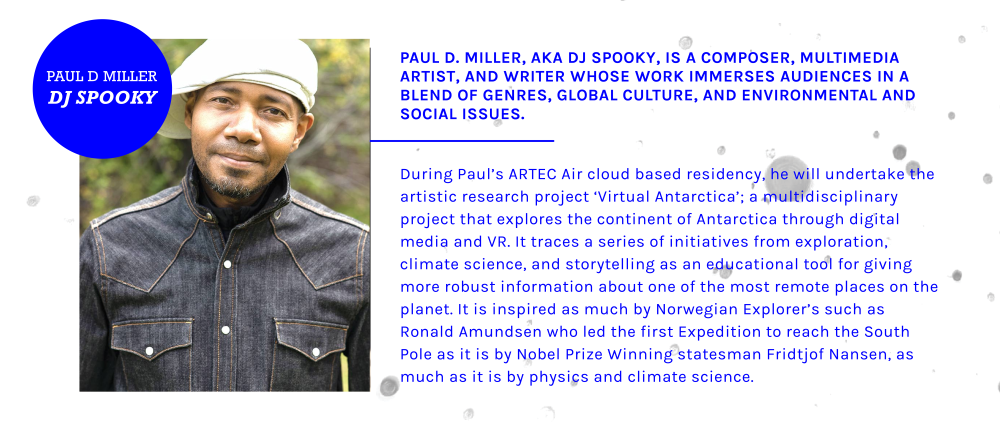Artist in Residence program

Cloud-based AiR @ NTNU, 2020.




AiR @ NTNU, 2019.

Poly-Art @ NTNU, 2018.
Dr. Alexandra Murray-Leslie is an academic pop-artist and co-founder of the art band Chicks on Speed. She’s currently a guest researcher at Animal Logic Academy, Faculty of Transdisciplinary Innovation, The University of Technology Sydney and Research Affiliate at CCC (Critical Curatorial Cybernetic Studies), HEAD, The University of Art and Design, Geneva. Alex has worked in the worlds of on-body technology, computer-aided design, and manufacturing, sports, art, fashion and entertainment.
https://www.kit.ntnu.no/en/content/artec-artist-residence-alex-murray-leslie-chicks-speed
For her work at NTNU, Alex Murray engaged in artistic research exploring art-science collaborations. She utilized her practive-based research skills to initiate cross-disciplinary conversations that resulted in a series of performances, interviews, and talks with issues ranging from bio-mechanics to sleep research. Highlights include;
- Underwent a sleep study documented through EEG equipment.
- Theatrical performance inside an anechoic chamber.
- Worshop performance showcasing her computer-enhanced foot devices that act as somatic wearable musical instruments.

VVifi4Garden, 2017.
Joan Heemskerk / B. 1968 Kaatsheuvel, Netherlands.
Dirk Paesmans / B. 1965 Brussels, Belgium.
JODI pioneered web-based art in the mid-1990s. By radically disrupting the conventions and functions of systems such as web pages, computer programs, video and computer games, mobile apps, and other digital technologies, JODI’s work destabilizes the relationship between computing technology and its users. JODI continue to work in the widest possible variety of media and techniques, from installations, software and websites to performances and exhibitions. JODI’s work is featured in most art historical volumes about electronic and media art, and has been exhibited worldwide at Documenta-X, Kassel; Stedelijk Museum, Amsterdam; ZKM, Karlsruhe; ICC, Tokyo; CCA, Glasgow; Guggenheim Museum, New York; Centre Pompidou, Paris; Eyebeam, NewYork; FACT, Liverpool; MOMI, New York, among others.
During their stay in Trondheim, JODI investigated the phenomenon of tracking, how smartphone signals and usage track our daily movement. In VVIFI4Garden”, a spatial site-specific work developed specifically for Adressaparken they ask: What if we were visually aware of that data and analytics? How would this influence the movement and experiences of those who pass through the park? JODI added local connectivity in Adressaparken, where visitors can have free WIFI, but in a sense WRONG WiFi. By channeling content controlled by visitors devices and geographical position, JODI created a new net topology within the park, to visualize the hidden waves of our digital behaviors and movements that we unconsciously already build.

Current, 2017.
B. 1987 Naarden, Nederland.
She received her education at The California Institute of the Arts, The Art Academy in Oslo and The Royal Academy of Art in The Hague. She lives and works in Trondheim. Mjølsnes works with photography, video and sound in installations where natural, digital, and human processes enter into dialogue. Her projects highlight phenomena or species that share an interconnected history with human mythologies. Through her work she creates situations where the viewer can think with and through materials as subjects.
B. 1986 Los Angeles, California.
Leisz holds a Bachelors of Fine Arts from The California Institute of the Arts. He is currently based in Los Angeles. Leisz is a new media artist and programmer who builds dynamic spaces of play and discovery centered around the surprising beauty that results through the hacking, breaking, and repurposing of commonplace technologies.
Michael Leisz and Hannah Mjølsnes developed a new interactive project for Adressaparken with the working title “Current.” Their work proposes a site-specific approach to the park, emphasizing one of its characteristics as being a place where people are in transition and passing by. How can an artwork be experienced when in movement? They worked with this by creating a visual and auditory layer on top of the park with recording from a geographically removed place; a glacier in Norway. A relationship is established between the action of the visitor, and the action of the water in the glacier, shaping its surfaces through freezing, melting and running through it. Michael Leisz is a programmer and artist who has worked extensively with engaging the audience in interactive works focused on communication through the senses. Hannah Mjølsnes is an artist whose primary medium is video and sculpture. She creates installations with large-scale projections of natural elements. Their collaborative work centers on human relations to natural and digital landscapes and processes.

